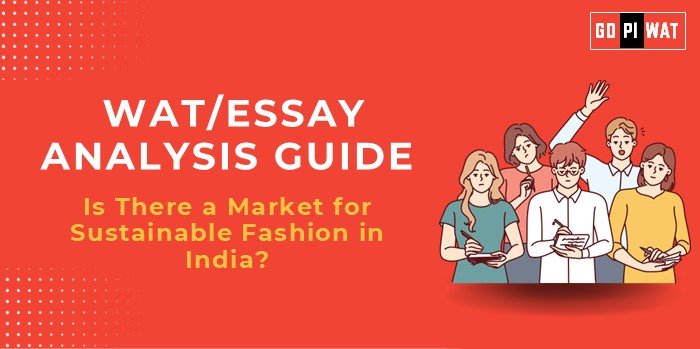📋 WAT/Essay Analysis Guide: Is There a Market for Sustainable Fashion in India?
🌐 Understanding the Topic’s Importance
The essay assesses one’s ability to evaluate sustainability’s relevance in a competitive, price-sensitive market like India, integrating themes of environmental impact, consumer behavior, and business opportunities.
⏳ Effective Planning and Writing
- Time Allocation:
- 📝 Planning: 5 minutes
- ✍️ Writing: 20 minutes
- 🔍 Review: 5 minutes
- Structure:
- 📜 Introduction: 70 words
- 📖 Body: 375 words
- 📄 Conclusion: 70 words
💡 Introduction Techniques for Essays
-
- Contrast Approach:
“While global brands emphasize sustainability, India’s consumer base is torn between affordability and ethical fashion.”
-
- Solution-Based Approach:
“India’s sustainable fashion market can thrive with innovations that balance cost and eco-friendliness.”
-
- Timeline Introduction:
“From ancient khadi to modern organic cotton, India’s journey with sustainable fashion reflects a blend of tradition and innovation.”
📖 Structuring the Essay Body
- Achievements:
- ✅ Growth in demand among urban, eco-conscious millennials.
- 🌿 Emergence of eco-conscious brands like B Label and Nicobar offering sustainable collections.
- 📜 Government support through initiatives promoting organic textiles and khadi.
- Challenges:
- ⚠️ Affordability remains a barrier for the majority of price-sensitive consumers.
- 📉 Awareness gaps, particularly in rural areas, limit market penetration.
- 🔗 Fragmented supply chains hinder scalability and consistent quality.
- Future Outlook:
- 🌐 Public-private partnerships to promote affordable and scalable green technology.
- 🧵 Subsidies for ethical brands to lower production costs and enhance competitiveness.
- 📣 Awareness campaigns using digital platforms to target diverse demographics.
📄 Concluding Effectively
-
- Balanced Perspective:
“Sustainable fashion in India holds immense potential but requires concerted efforts to balance innovation, cost, and inclusivity.”
-
- Global Comparison:
“India can emulate Nordic models by fostering affordability and awareness while retaining its unique cultural touch.”
🚀 Recommendations for Sustainable Progress
- 📣 Public Awareness Campaigns: Bridge the urban-rural gap through targeted marketing initiatives.
- 🧵 Cost Innovations: Develop affordable sustainable alternatives, leveraging economies of scale to reduce prices.
- 📜 Policy Incentives: Offer subsidies for ethical brands and support green technologies to boost adoption.
✍️ Sample Short Essays
-
- Balanced Perspective:
“India’s market for sustainable fashion is evolving, driven by urban awareness and innovative brands. However, affordability and scalability remain critical challenges. Solutions lie in leveraging technology and inclusive policies to transform niche trends into mainstream practices.”
-
- Solution-Oriented:
“Affordable sustainable fashion is India’s key to addressing fast fashion’s environmental and social costs. Innovations in low-cost green fabrics, coupled with subsidies and digital marketing, can make sustainable fashion accessible across socio-economic strata.”
-
- Global Comparison:
“India’s fashion sector can emulate Nordic success by merging sustainability with affordability. Export-driven growth and domestic awareness can position India as a leader in eco-fashion, leveraging its cultural richness and skilled workforce.”


